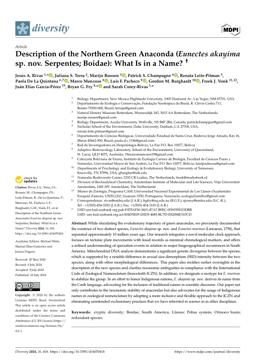2024-07-18
Description of the Northern Green Anaconda (Eunectes akayima sp. nov. Serpentes; Boidae): What Is in a Name?
Publication
Publication
Diversity , Volume 16 - Issue 7 p. 418- 418
While elucidating the evolutionary trajectory of green anacondas, we previously documented the existence of two distinct species, Eunectes akayima sp. nov. and Eunectes murinus (Linnaeus, 1758), that separated approximately 10 million years ago. Our research integrates a novel molecular clock approach, focuses on tectonic plate movements with fossil records as minimal chronological markers, and offers a refined understanding of speciation events in relation to major biogeographical occurrences in South America. Mitochondrial DNA analysis demonstrates a significant genetic divergence between the species, which is supported by a notable difference in sexual size dimorphism (SSD) intensity between the two species, along with other morphological differences. This paper also rectifies earlier oversights in the description of the new species and clarifies taxonomic ambiguities in compliance with the International Code of Zoological Nomenclature (henceforth ICZN). In addition, we designate a neotype for E. murinus to stabilize the group. In an effort to honor Indigenous nations, E. akayima sp. nov. derives its name from the Carib language, advocating for the inclusion of traditional names in scientific discourse. Our paper not only contributes to the taxonomic stability of anacondas but also advocates for the usage of Indigenous names in zoological nomenclature by adopting a more inclusive and flexible approach to the ICZN and eliminating unintended exclusionary practices that we have inherited in science as in other disciplines.
| Additional Metadata | |
|---|---|
| , , , , , , | |
| doi.org/10.3390/d16070418 | |
| Diversity | |
| Released under the CC-BY 4.0 ("Attribution 4.0 International") License | |
| Organisation | Staff publications |
|
Rivas, Jesús A., Terra, Juliana S., Roosen, Marijn, Champagne, Patrick S., Leite-Pitman, Renata, De La Quintana, Paola, … Corey-Rivas, Sarah. (2024). Description of the Northern Green Anaconda (Eunectes akayima sp. nov. Serpentes; Boidae): What Is in a Name?. Diversity, 16(7), 418–418. doi:10.3390/d16070418 |
|
